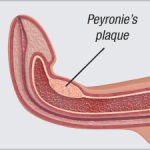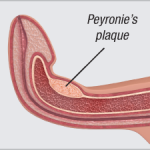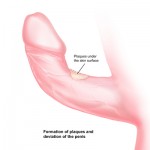What is Peyronie’s disease? When you develop fibrous scar tissue on the penis, you suffer from a condition that experts term Peyronie’s disease. This can result in painful and curved erections. This condition is noncancerous but can lead to erectile dysfunction. It’s important to remember that penises are of different sizes and shapes. Having curved erections does not necessarily mean that you suffer from a specific condition. In the case of Peyronie’s disease, you suffer from severe pain, with some men facing a significant bend in their erections.

(Source)
The disease might affect your ability to have sex, or you may find it difficult to maintain an erection. Besides causing anxiety and stress in many men, Peyronie’s disease also leads to penile shortening. The condition stabilizes or grows worse with time. Consulting your doctor and beginning treatment during the initial stages can help alleviate the condition. Even if you have faced the condition for some time, proper treatment can help with some symptoms.
Symptoms of Peyronie’s Disease
This disorder usually affects the top of the penis. The development of plaque decreases tunica albuginea’s flexibility. It stiffens the penis, causing it to bend upwards. If the plaque develops at the bottom of your penis, it bends the penis sideways or downwards. It is possible for more than one plaque to develop. This causes complexity in the curves.
In some conditions, the plaque forms all around the penis. This won’t cause the penis to curve, but the shaft will become narrow like the bottle’s neck. You can refer to this disorder as waiting or bottle-necking. In severe conditions, the plaque absorbs calcium and hardens to become bone-like. Furthermore, you might also experience shortening of the penis. Here are some other signs of Peyronie’s diseases:
- Painful erections
- Curved/bent penis
- Lumps in the penis
- Soft erections
- Problems having sex due to curvy penis
Peyronie’s disease will affect your quality of life. Most men dealing with the condition fail to seek timely medical help because they feel embarrassed. This can lead to depression and stress in almost 75 out of 100 men suffering from this disorder.
Stages of Peyronie’s Disease
There are two stages of Peyronie’s disease: chronic and acute
· Acute Phase
Scute Peyronie’s disease lasts for six to twelve months. You can experience pain when your penis is either flaccid or erect. In this stage, the scar under the skin changes the shape of the penis, causing curvature.
· Chronic Phase
The scar will stop growing in this stage, so the penis doesn’t bend any further. The pain goes away with time, but most people continue to feel extreme pain during erections. If your condition is chronic, you may develop erectile dysfunction.
Diagnosis for Peyronie’s Disease
When consulting your doctor, it’s important to discuss doctoral your symptoms. They will ask if you developed the condition after an injury or have been dealing with symptoms for a long time. The doctor will also examine the tissues that are hardening because of the disease. In some cases, the doctor may need to evaluate the penis’ condition during an erection. For that, they will inject a solution to cause an erection. The doctor will take an ultrasound or X-ray of the penis to inspect and confirm the condition you’re facing. He may conduct a biopsy and remove the tissue for lab tests as well.
Treatments for Peyronie’s Disease
Before treatment, your doctor will ask you to wait a year or two as the condition may improve on its own. If you face a mild condition, you won’t require any treatment. During that time, you will only experience pain when the penis is erect. If Peyronie’s disease is not affecting your sex life, you won’t need treatment.

(Source)
If your doctor identifies any need for treatment, they will either prescribe medicine or consider surgery. In the case where medication doesn’t work, you need to get collagenase shots or verapamil for the affected area. If that treatment fails to improve your condition and the disorder affects your sex life, you need to undergo surgery for Peyronie’s disease. Here are the two common surgeries in these situations:
- The doctor will remove the plaque and add tissue to the affected area
- They might also remove the tissue opposite to the plaque, countering the bending effect
These procedures are not a common solution for Peyronie’s disease, and the above surgeries can lead to complications. The first method may cause erection problems, and the second one will shorten the length of your erect penis. You can also choose penile prosthesis implants if you have erectile dysfunction and suffer from Peyronie’s disease.
Peyronie’s Disease: Conclusion
If you want to consult with a professional urologist for Peyronie’s disease or Penile Dysfunction, contact us at 212-370-4170. At Fifth Avenue Urology, you can discuss your condition with Dr. Yaniv Larish, an expert in treating men and women’s urological and reproductive system disorders.

 Dr. Larish is a urologist and surgeon treating women and men with a variety of urological conditions. His expertise is in treating complex kidney stones, enlarged prostates (BPH), incontinence, erectile dysfunction, infertility, and urological oncology (prostate, bladder, kidney, and adrenal cancers). He is an expert in general urology and is often consulted for second opinions.
Dr. Larish is a urologist and surgeon treating women and men with a variety of urological conditions. His expertise is in treating complex kidney stones, enlarged prostates (BPH), incontinence, erectile dysfunction, infertility, and urological oncology (prostate, bladder, kidney, and adrenal cancers). He is an expert in general urology and is often consulted for second opinions.





 In men, Peyronie’s disease can come on suddenly or develop over time. Generally, the symptoms of this condition include:
In men, Peyronie’s disease can come on suddenly or develop over time. Generally, the symptoms of this condition include:
 Exercise and massage also play a crucial role in the treatment of Peyronie’s disease. These techniques can help reduce the curvature of the penis and soften the plaque. Stretching exercises, specifically, have shown promising results. To perform these exercises, start by placing a warm towel on your penis for five minutes to improve blood flow. Then, Dr. Larish recommends two common stretching exercises:
Exercise and massage also play a crucial role in the treatment of Peyronie’s disease. These techniques can help reduce the curvature of the penis and soften the plaque. Stretching exercises, specifically, have shown promising results. To perform these exercises, start by placing a warm towel on your penis for five minutes to improve blood flow. Then, Dr. Larish recommends two common stretching exercises: